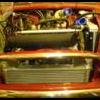Best 175/50/13 Tyres
#31

Posted 19 April 2013 - 09:47 AM
A stiff damper with a heavy wheel and reduced suspension compliance from a low-profile tyre will result in a reduction in tyre contact with the road surface over bumps because it is then 'over-damped'. The last thing you need with a heavy wheel is an over damped spring as this will simply make the vehicle jittery due to the tyre not staying in optimum contact with the road surface.
#32

Posted 19 April 2013 - 10:01 AM
#33

Posted 19 April 2013 - 12:31 PM
#34

Posted 19 April 2013 - 01:05 PM
You seem be under the impression that the damper (shock absorber) has some sort of rebound. Which they don't......
Thats not correct
Bump (or compression) is when the shock rod is compressed into the shock body. Rebound (or extension) is when that rod is extended from the shock body the same shock can have different bump and rebound characteristics. You can have a shock that has a slow bump (hard to compress) but a fast rebound (easy to extend). Cars with low profile tyres and the shock absorbers set to hard wheel spin in the wet and find it difficult to find grip coming out of corners, by backing the shocks pre-load off the wider tyre is able to follow the contor of the road as Cooperman has pointed out above
#35

Posted 19 April 2013 - 03:56 PM
I'd suggest if you really think that to be the case you all remove your cones (springs) and see how far you get, just running with dampers........
Once again your missing the point I dont know if you do it on purpose to agigate people, or its simply a field you haven't grassped properly, I didn't mention anything about springs
You said "You seem be under the impression that the damper (shock absorber) has some sort of rebound. Which they don't......"
I replied saying that your information is incorrect, they do in fact some competition shocks have compression and rebound damping adjustment.
#36

Posted 19 April 2013 - 05:16 PM
I don't wish to be immodest, but suspension, ride & handling, especially but not exclusively on rally cars, is an area where I have quite a lot of experience and have had some success.
To give a fully detailed explanation of all the factors and how to achieve the optimum for any given use would take several pages, so I'll simplify it by just referring back to my earlier posts on this and adding as follows:
On the subject of dampers, there are several different operating modes available.
For example, the original KONI damper was adjustable, but was soft on bump and stiff on rebound, this being fairly good for keeping the wheels in contact with the road on average roads. The limitation was that over a series of bumps, the rebound was a bit too stiff and it was likely that the suspension could still be a bit compressed after the first bump when an immediate second bump or third bump could cause the suspension to 'bottom' out. Increasing the bump stiffness more also increased the rebound stiffness even more, so KONIs didn't suit all applications or even all cars.
For a bumpy road a slightly stiffer bump with a softer re-bound can work well as the spring can easily get back to it's 'normal' ride length.
Most modern gas-filled dampers, like GAZ, SPAX, etc., have a built-in rebound spring effect which works well. The adjustable ones can be 'dialled-in' to give a damping rate to suit general driving conditions (i.e. bumpy public roads)and to match the tyre design and aspect ratio.
Now, with a low-profile tyre, the tyre wall depth is less than normal, so the spring effect normally provided by the tyre is reduced, which means that the spring has to do the 'lost' part of that job, even though the 'spring rate' will be a higher rate than the tyre distortion would normally be. That is why the suspension needs to be raised a bit, to re-gain the lost suspension travel provided by the tyre. But, if the damper is a bit too hard the damper is then attempting to do a part of the spring's job, which it was not designed to do and, in doing so and with a heavier wheel, the end result will be that the car arrives at a bump, the higher wheel inertia means the wheel is reluctant to move vertically and this reluctance is added to by the spring/damper combination. So the answer is to raise the suspension a bit and reduce the damping force on 'bump' travel to allow the wheel to rise more easily. If this is not done the tyre contact with the road will be reduced, which is most definitely not what is wanted.
So, in a nutshell, to use a 175/50 x 13 tyre you need to raise the ride height to allow a bit more suspension travel and soften off the dampers a bit to allow easier vertical wheel travel under 'bump' loadings.
If the spring and dampers are not matched to the wheel and tyre, or even to each other, it is easy to get a car which is under-sprung and over-damped - a very poor combination.
I'm sorry if this is a bit long, but to explain even more fully would be several times longer. I hope this is sufficient explanation. If more explanation or a more detailed tutorial is needed just ask, but please don't put 7 question marks or it'll end up 7 times longer. Edited to add: I just had a visit from a young guy who is about to complete his degree in Automotive Eng with Motorsport and I posed the question "If you were going to fit heavier wheels with lower profile tyres to a car what would you do to maintain driveability in terms of suspension set-up?" His answer was, "soften the damping slightly and, if possible, change the initial spring rate to give a lower rate for the first few cms of spring compression".
Edited by Cooperman, 19 April 2013 - 07:00 PM.
#37

Posted 20 April 2013 - 09:33 AM
Reading your comments on lots of posts you obviously have been around Minis a long time and have lots of technical knowledge when you apply yourself, but when you make statement like the above thats pretty basic stuff even kids reading mags understand shocks do have a rebound loading and not just a compression loading. I learn something every day from TMF its a source and wealth of information. Rather than mud slinging would it not be better to research and write a response if you disagree with the OP, that way everyone gets to see a discussion, rather than "that wont work"
#38

Posted 20 April 2013 - 10:12 AM
I tell you what, why don't you fit 13s with whatever settings you like and let Cooperman choose his size and settings and do a few laps. Whoever comes over the line first is right. I know who my money is on................................ (Lots of full stops as I know you like them)Once again you seem to think your talking to someone who hasn't been there and done it...........You really need to get over the question marks cooperman.
A heavier wheel and tyre exerts more force on the suspension, if you compress a spring with more weight it will continue to bounce. The damper is there to restrict that bounce and if something is heavier it needs more of damping to control that bounce.
For your information correctly fitted dampers/shockers have not effect on ride height........
As for the statement above it shows you fundamentally misunderstand what is happening in a cars suspension in the circumstances you describe. People have tried to explain it nicely but the only reply seems to be 'I am an expert so you are all wrong'. It is a very childish way to go about things isn't it????????????? (Just for you again
#39

Posted 20 April 2013 - 10:37 AM
I tell you what, why don't you fit 13s with whatever settings you like and let Cooperman choose his size and settings and do a few laps. Whoever comes over the line first is right. I know who my money is on................................ (Lots of full stops as I know you like them)
As for the statement above it shows you fundamentally misunderstand what is happening in a cars suspension in the circumstances you describe. People have tried to explain it nicely but the only reply seems to be 'I am an expert so you are all wrong'. It is a very childish way to go about things isn't it????????????? (Just for you again)
LOL right you explain to me what you think the damper does........
Before anyone posts again, can I please ask that they at least do a little research.........
What is the point? I will spend 10 minutes typing and you won't listen anyway. Others have tried to explain nicely and you are just rude. It spoils the forum for others. Can't you see how offensive you come across to others? And as for suggesting others should do research, well.........................
#40

Posted 20 April 2013 - 11:37 AM
we all seem to agree on the fact that dampers damp in both bump and rebound, but you are adamant that they don't and are being a complete toolbox about it.
sadly this seems to happen fairly often where you are involved.
#41

Posted 20 April 2013 - 03:30 PM
#42

Posted 20 April 2013 - 06:13 PM
#43

Posted 20 April 2013 - 09:46 PM
Lucky you never played football DG the goal posts would never be in the same place twice. I agree there is indeed someone who does not understand what a damper does. Now weve cleared that up I think we can all move on.
Edited by KernowCooper, 20 April 2013 - 09:47 PM.
#44

Posted 20 April 2013 - 09:49 PM
You fail to grasp that in damping the spring it actually controls the way the spring rate is actually applied to the suspension arm or strut both in compression and in rebound and on single rate and on rising rate springs. That, in turn, determines the ability of the tyre to stay in contact with the road. It is far, far more complex than you seem to realise or are willing to accept. There is a piece of kit called a '7-axis shaker rig', which costs a small fortune and which is used to confirm the design of damper & spring settings and rates across a variety of wheels, tyres and surfaces and to 'fine tune' these. If it were as simple as you allude to it being, then such kit would be unnecessary. I am simply amazed that you cannot see that a softer setting is necessary with a heavier wheel and lower profile tyre, but if you won't be told, despite asking the question, so be it. 'None so blind as those who will not see'.
I tell you what, why don't you fit 13s with whatever settings you like and let Cooperman choose his size and settings and do a few laps. Whoever comes over the line first is right. I know who my money is on................................ (Lots of full stops as I know you like them)
As for the statement above it shows you fundamentally misunderstand what is happening in a cars suspension in the circumstances you describe. People have tried to explain it nicely but the only reply seems to be 'I am an expert so you are all wrong'. It is a very childish way to go about things isn't it????????????? (Just for you agai )
LOL right you explain to me what you think the damper does........
Before anyone posts again, can I please ask that they at least do a little research.........
What is the point? I will spend 10 minutes typing and you won't listen anyway. Others have tried to explain nicely and you are just rude. It spoils the forum for others. Can't you see how offensive you come across to others? And as for suggesting others should do research, well.........................
Sorry but you never explained anything, for your information I ran 13's for about ten years. Before that in the always used tens, I've now converted back to 10's.
The main problem here is nobody seems to understand what a damper does and the clue is in the name. ie. it dampens the movement of the spring (cone).............
If none can understand this there is no point even trying to explain it..........
#45

Posted 21 April 2013 - 12:10 AM
1 user(s) are reading this topic
0 members, 1 guests, 0 anonymous users



 This topic is locked
This topic is locked















